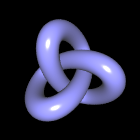Art Circles -- Part 2
Recently I learned that 'tondo' a shortening of the Italian 'rotondo' i.e. 'round' is the word used in the art world for round paintings as shown in my last post. Today let me move temporarily away from tondos and show some interesting art involving circles in which the paintings are not circular. First is a painting by Arthur Dove (1880-1946), arguably the first American abstract painter. Here it is:
Arthur Dove, 'Red Sun', 1935
I really like that large red sun, at once a natural object, a three dimensional spiral, and a symbol. The muted red stripes in the foreground seem agricultural. The image is both austere and yet warm. Even the artists signature in the lower middle seems part of the composition.
The next image is a painting of Chagall. I am not sure I can put into words why I find it compelling. Stare at it a bit, because it will just have to speak for itself.

Next is a strange glowing circle in a sort-of landscape by Christopher Orr. I hope you like it.

Christopher Orr, Untitled (Circle), 2006

Classical Greek Ceramic Work, 2000 or more years ago

Rembrandt, 'Self-Portrait with two Circles', 1665-1669
The next image is a painting of Chagall. I am not sure I can put into words why I find it compelling. Stare at it a bit, because it will just have to speak for itself.
Chagall, 'Compostion aux Cercles et à la Chèvre', 1920
Next is a strange glowing circle in a sort-of landscape by Christopher Orr. I hope you like it.
Christopher Orr, Untitled (Circle), 2006
Christopher Orr is a contemporary artist, born in 1967. You can find more about him, and see more of his work, by looking at his CV at IBID PROJECTS, London.
Now, let us step back two millennia and compare Christopher Orr's painting with this image on a classical Greek bowl:
Classical Greek Ceramic Work, 2000 or more years ago
There is a similarity in that both images feature a man seemingly enamored with a circle. In the first image the man seems amazed that he can make a circle of light with his finger, while perhaps in the Greek image the man is simply enjoying the pleasure of rolling a hoop. Certainly I do not know. Perhaps a more knowledgeable person can explain the symbolism, if any, of the circle. The rooster in the Greek image is the symbolic gift of love, or perhaps more often an offer understood to imply a desire for sex. But, in this case, there is no other person in the image. I still have to wonder if Orr might have been influenced by this or some similar Greek image from another era.
For today's last image let us move forward, past the Renaissance, to the Dutch Golden Age and examine this self-portrait of Rembrandt in older age:
Rembrandt, 'Self-Portrait with two Circles', 1665-1669
I think the circles add something important to the picture. Without them the painting would be much less interesting.
This series of circles in art will be continued in some future postings.
This series of circles in art will be continued in some future postings.

No comments:
Post a Comment